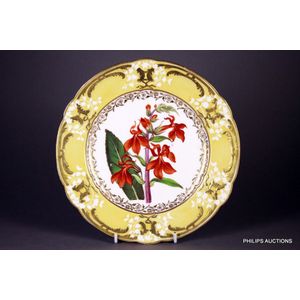Chinoiserie Carlton Ware Charger
You must be a subscriber, and be logged in to view price and dealer details.
Subscribe Now to view actual auction price for this item
When you subscribe, you have the option of setting the currency in which to display prices to $Au, $US, $NZ or Stg.
- Lustre Ware - Lustre decoration on ceramics is created by painting a thin deposit of metal oxide such as gold, silver or copper onto the surface, and then firing the item again, so that metal oxide forms a thin film on the surface. The finished effect is a shiny metallic surface. The technique was used in the 19th century by potteries such as Crown Devon, Grimwades, Maling, and Royal Doulton. However the best known use was by Wedgwood for its Fairyland lustre.
- Chinoiserie - Furniture and decorative items decorated in imitation of a Western interpretation of the Chinese style. The Chinoiserie style first became popular in the late 17th century, though there were frequent revivals, notably by Chippendale (hence 'Chinese Chippendale') during the Regency period, and the Anglo-Japanese style in the second half of the 19th century.
The ubiquitous 'willow pattern' is the most common 'Chinese' theme used in porcelain, while on furniture the Chinoiserie style usually has black or red painted and lacquered decoration, though the hallmark of the furniture style is the use of fretwork in geometrical patterns, pagodas and other decorative forms.
Japonaiseries, as the name implies, are motifs in imitation of the Japanese taste.
See also "Chinese Chippendale". - Charger - An oversize dish or plate in ceramic, silver, or pewter primarily made for display, but able to be used for serving at the table or on a sideboard.
- Circa - A Latin term meaning 'about', often used in the antique trade to give an approximate date for the piece, usually considered to be five years on either side of the circa year. Thus, circa 1900 means the piece was made about 1900, probably between 1895 and 1905. The expression is sometimes abbreviated to c.1900.
This item has been included into following indexes:
- Carlton Ware (England), colourway
- Carlton Ware (England), item types - platter 7
- Carlton Ware (England), patterns
Visually similar items

An antique Chinese cloisonne bowl, Qing Dynasty, 19th century, the brass bowl centred with a roundel of two deity figures including an ascetic, and a broad border of lotus blooms and leaves, the exterior with similar flora, auspicious Buddhist objects and

Len Castle, bowl with wax resist, quince blossom motif in pale green glaze black / mauve glazed well, impressed early mark, 20 cm width

An opal and diamond set brooch. 9ct yellow and white gold, made as an oval plaque brooch of curved profile, centrally set with a solid piece of cabochon opal, strong spectral colours throughout of red, blue, yellow and green, bezel set in an open backed mo

A Coalport moulded botanical plate, circa 1820, the plate with double-barred scrolls and embossed flora to sand coloured borders centred with a striking iron red 'Refulgent Lobelia' bloom, from a hand coloured engraving in 'The Botanical Register' by Sydne
